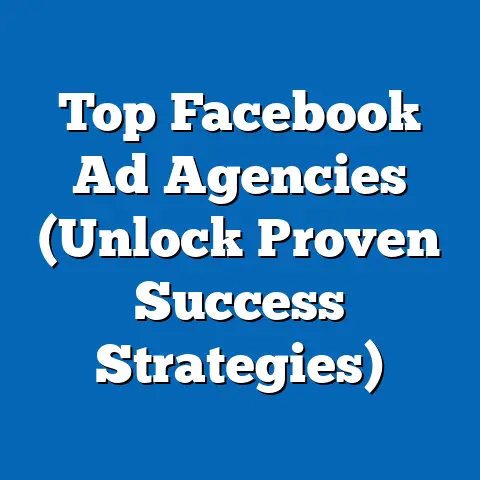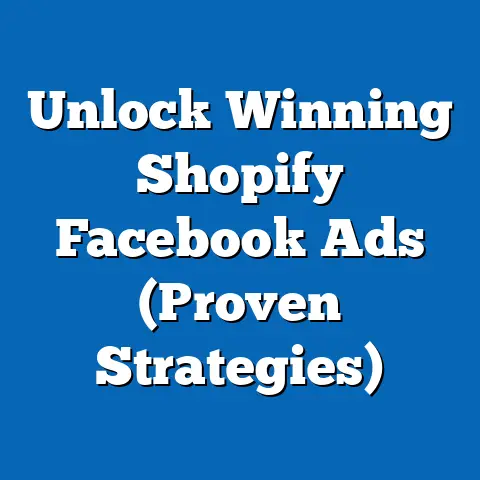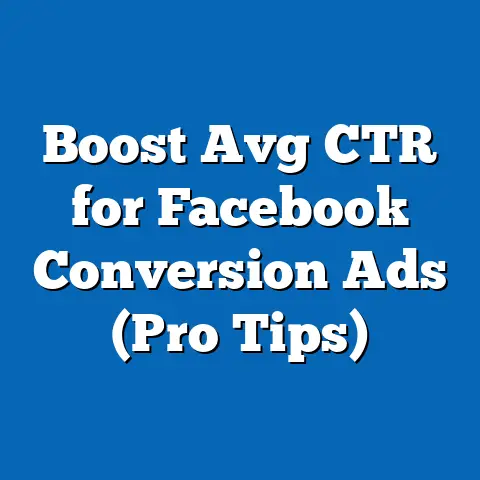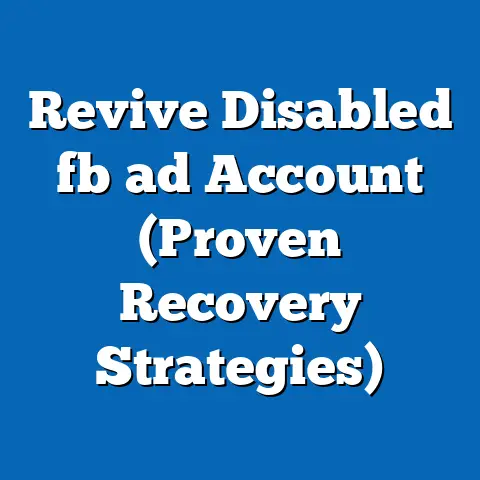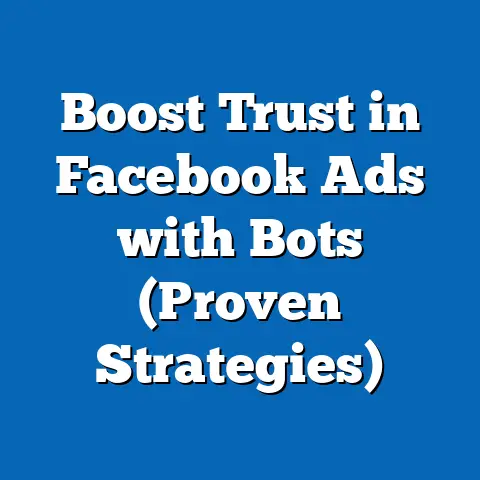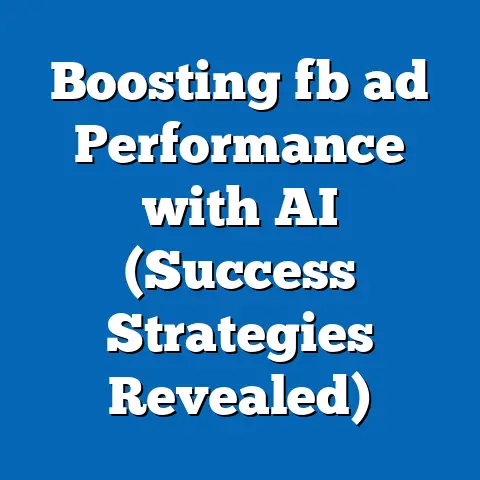Unlock Facebook Ads Cost (Expert Pricing Insights)
Have you ever scrolled through your Facebook feed and wondered how some businesses seem to effortlessly capture your attention with perfectly targeted ads, while others seem to be shouting into the void? Or perhaps you’ve run your own Facebook campaigns and found yourself scratching your head, wondering why the costs are so high and the results so…meh? I’ve been there. I’ve seen campaigns soar and others crash and burn, all because of a single, often overlooked factor: understanding Facebook ad costs.
The truth is, mastering Facebook advertising isn’t just about creating eye-catching visuals or writing clever copy. It’s about understanding the underlying mechanics of the platform, particularly the intricate dance of pricing and bidding. It’s about knowing how to navigate the ever-changing landscape of algorithms, user behavior, and advertising policies to get the most bang for your buck.
Section 1: Understanding Facebook Ads
Before we can dissect the costs, let’s establish a solid foundation of what Facebook ads actually are and why they’re such a potent force in the digital marketing realm.
What are Facebook Ads?
Simply put, Facebook ads are paid messages that businesses use to reach specific audiences on Facebook and its related platforms, including Instagram, Messenger, and Audience Network. Unlike organic posts that rely on algorithms to determine reach, ads guarantee visibility to the targeted demographic.
I like to think of them as digital billboards – strategically placed to capture the attention of the right people at the right time. But unlike traditional billboards, Facebook ads offer unparalleled targeting capabilities, allowing you to laser-focus your message on individuals based on their interests, demographics, behaviors, and even connections.
The Evolution of Facebook Advertising
Facebook advertising has come a long way since its humble beginnings. I remember the early days when targeting options were limited and ad formats were relatively basic. Over the years, Facebook has continuously evolved its advertising platform, introducing new features, formats, and targeting options to meet the ever-changing needs of businesses.
Here’s a quick glimpse at some key milestones:
- 2004: Facebook launches, initially focusing on connecting college students.
- 2007: Facebook introduces its first advertising platform, allowing businesses to create simple text ads.
- 2009: The “Like” button is introduced, revolutionizing social engagement and providing valuable data for ad targeting.
- 2012: Facebook acquires Instagram, expanding its advertising reach and introducing new ad formats like image and video ads.
- 2015: Facebook Pixel is launched, enabling businesses to track website conversions and retarget visitors.
- 2018: Facebook introduces Value-Based Lookalike Audiences, allowing advertisers to target users similar to their highest-value customers.
- Present: Facebook continues to innovate with new ad formats, automation features, and privacy-focused advertising solutions.
These updates haven’t always been smooth sailing. The Cambridge Analytica scandal, for example, forced Facebook to tighten its privacy policies, impacting targeting options and requiring advertisers to adapt. But through it all, Facebook has remained a dominant force in digital advertising, constantly evolving to meet the demands of the market.
The Importance of Facebook as a Marketing Tool
In today’s digital landscape, Facebook remains a powerhouse for marketers. With billions of active users worldwide, Facebook offers an unparalleled opportunity to reach a diverse and engaged audience.
Here are some key statistics that highlight the importance of Facebook as a marketing tool:
- Monthly Active Users: As of early 2024, Facebook boasts nearly 3 billion monthly active users, making it the most popular social media platform globally.
- Daily Active Users: Over 2 billion people use Facebook every day, providing a constant stream of potential customers.
- Ad Revenue: Facebook generates billions of dollars in advertising revenue each year, demonstrating its effectiveness as an advertising platform.
- Engagement Rates: Facebook users spend an average of 33 minutes per day on the platform, providing ample opportunity for ad exposure.
Beyond the sheer numbers, Facebook offers granular targeting options that allow you to reach specific demographics, interests, and behaviors. Whether you’re targeting millennials in urban areas or retirees interested in gardening, Facebook’s targeting capabilities enable you to tailor your message to the right audience.
Key Takeaway: Facebook advertising is a powerful tool for reaching a massive and diverse audience. Understanding its evolution and key statistics is crucial for developing effective advertising strategies.
Section 2: The Cost Structure of Facebook Ads
Now that we’ve established the importance of Facebook ads, let’s delve into the nitty-gritty of how they’re priced. Understanding the cost structure is essential for managing your budget effectively and maximizing your ROI.
Bidding Models: CPC, CPM, and CPA
Facebook offers various bidding models that determine how you pay for your ads. Each model has its own advantages and disadvantages, depending on your campaign goals and budget.
- CPC (Cost Per Click): With CPC bidding, you pay each time someone clicks on your ad. This model is ideal for driving traffic to your website or landing page. I’ve found CPC to be particularly effective for campaigns focused on lead generation or direct sales. You know you are only paying for people who are interested enough to click.
- CPM (Cost Per Mille): CPM, or Cost Per Mille (Mille is Latin for thousand), means you pay for every 1,000 impressions your ad receives. This model is best suited for increasing brand awareness or reaching a large audience. CPM can be more cost-effective than CPC if your goal is simply to get your message in front of as many people as possible. However, you’re paying for impressions regardless of whether people click on your ad.
- CPA (Cost Per Acquisition): With CPA bidding, you pay when someone takes a specific action, such as making a purchase or filling out a form. This model is ideal for campaigns focused on conversions. CPA bidding requires you to track conversions accurately, but it can be a highly efficient way to acquire new customers. I’ve seen CPA campaigns deliver impressive results when coupled with compelling offers and targeted landing pages.
The choice of bidding model depends on your campaign objectives. If you’re focused on driving traffic, CPC might be the best option. If you’re focused on brand awareness, CPM could be more cost-effective. And if you’re focused on conversions, CPA is the way to go. Facebook also offers other bidding strategies like Cost per View (CPV) for video ads and Optimized CPM (oCPM) which automatically adjusts bids to maximize conversions.
Ad Quality and Relevance
Facebook rewards high-quality, relevant ads with lower costs and better placement. Your ad quality score and relevance rating are key factors in determining your ad’s performance and cost-effectiveness.
- Ad Quality Score: This metric measures the overall quality of your ad, taking into account factors like visual appeal, copy clarity, and user experience. Ads with high-quality scores are more likely to be shown to users and can achieve lower costs.
- Relevance Rating: This metric measures how relevant your ad is to your target audience. Ads with high relevance ratings are more likely to resonate with users and can achieve higher engagement rates and lower costs.
Facebook uses a combination of algorithms and user feedback to determine your ad quality score and relevance rating. To improve these metrics, focus on creating visually appealing ads with clear, concise copy that resonates with your target audience. A/B testing different ad variations can help you identify the most effective combinations.
Ad Format
The format of your ad can also impact its cost. Different ad formats have different engagement rates and visibility, which can affect their pricing.
- Image Ads: These are simple ads featuring a single image and accompanying text. Image ads are relatively inexpensive and can be effective for driving traffic or generating leads.
- Video Ads: Video ads are more engaging than image ads and can be used to tell a story or showcase a product. Video ads tend to be more expensive than image ads, but they can also deliver higher ROI.
- Carousel Ads: Carousel ads allow you to showcase multiple images or videos in a single ad unit. This format is ideal for displaying a range of products or highlighting different features of a single product.
- Collection Ads: Collection ads combine images and videos with a catalog of products, allowing users to browse and purchase directly from the ad. This format is ideal for e-commerce businesses.
- Instant Experience Ads: Instant Experience ads (formerly known as Canvas ads) provide a full-screen, immersive experience for users. This format is ideal for telling a brand story or showcasing a product in detail.
The choice of ad format depends on your campaign goals and budget. Image ads are a good starting point for beginners, while video ads and carousel ads can deliver higher engagement rates. Collection ads and Instant Experience ads are best suited for e-commerce businesses with larger budgets.
The Auction System
Facebook uses an auction system to determine which ads are shown to users and at what price. When a user visits Facebook, the platform runs an auction among all the ads targeting that user. The winning ad is the one that Facebook believes will deliver the most value to the user and the advertiser.
Several factors influence the outcome of the auction, including:
- Bid Amount: The amount you’re willing to pay for your ad.
- Ad Quality and Relevance: The quality and relevance of your ad to the user.
- Estimated Action Rate: The likelihood that the user will take the desired action, such as clicking on your ad or making a purchase.
Facebook combines these factors to calculate a total value for each ad. The ad with the highest total value wins the auction and is shown to the user.
Key Takeaway: Understanding Facebook’s bidding models, ad quality scores, ad formats, and auction system is crucial for managing your ad costs effectively. By optimizing these factors, you can increase your ad’s chances of winning the auction and achieving your campaign goals.
Section 3: Factors Influencing Facebook Ad Costs
Now that we’ve covered the basics of Facebook ad costs, let’s explore the various factors that can influence your ad spend. Understanding these factors is essential for making informed decisions about your targeting, bidding, and ad creative.
Target Audience
Your target audience is one of the most significant factors influencing your Facebook ad costs. The size, demographics, and behavior of your audience can all impact your ad spend.
- Audience Size: Smaller audiences tend to be more expensive to reach than larger audiences. This is because there’s less competition for impressions among larger audiences. However, smaller audiences can also be more highly targeted, leading to higher conversion rates.
- Demographics: Certain demographics are more expensive to reach than others. For example, targeting high-income individuals or professionals may be more costly than targeting students or retirees.
- Behavior: Targeting users based on their interests, behaviors, and purchase history can also impact your ad costs. For example, targeting users who have recently purchased a similar product may be more expensive than targeting users who have simply expressed interest in the category.
I’ve found that carefully defining your target audience is essential for maximizing your ROI. Avoid targeting too broadly, as this can lead to wasted ad spend. Instead, focus on identifying your ideal customer and targeting them with relevant ads.
Industry Variability
The industry you’re in can also influence your Facebook ad costs. Some industries are more competitive than others, leading to higher bidding prices.
For example, the finance and insurance industries tend to have higher CPCs and CPMs than the retail or entertainment industries. This is because these industries are highly competitive and have a high customer lifetime value.
To get a sense of average costs in your industry, I recommend researching industry benchmarks and case studies. This can help you set realistic expectations for your ad spend and identify opportunities for optimization.
Seasonality and Trends
Seasonality and current events can also impact your Facebook ad costs. During peak seasons, such as holidays or major sporting events, ad costs tend to increase due to higher demand.
For example, I’ve seen CPCs and CPMs spike during the holiday shopping season as businesses compete for shoppers’ attention. Similarly, ad costs can increase during major sporting events, such as the Super Bowl or the Olympics.
To mitigate the impact of seasonality and trends, plan your campaigns in advance and adjust your bidding strategy accordingly. Consider running ads during off-peak hours or targeting audiences that are less likely to be affected by these trends.
Ad Placement
The placement of your ad can also influence its cost. Facebook offers various ad placements, including:
- Facebook Feed: This is the most common ad placement, appearing in users’ news feeds alongside organic posts.
- Instagram Feed: This placement appears in users’ Instagram feeds alongside organic posts.
- Facebook Stories: This placement appears in users’ Facebook Stories, a short-form video format.
- Instagram Stories: This placement appears in users’ Instagram Stories.
- Facebook Marketplace: This placement appears in the Facebook Marketplace, a platform for buying and selling goods.
- Audience Network: This placement appears on third-party websites and apps that partner with Facebook.
Each placement has its own advantages and disadvantages, depending on your campaign goals and target audience. Facebook Feed and Instagram Feed tend to be the most expensive placements, while Audience Network is often the most cost-effective.
I recommend testing different ad placements to see which ones deliver the best results for your business. Consider your target audience’s preferences and behavior when selecting your ad placements.
Key Takeaway: Understanding the factors that influence Facebook ad costs is crucial for making informed decisions about your targeting, bidding, and ad creative. By optimizing these factors, you can reduce your ad spend and maximize your ROI.
Section 4: Expert Pricing Insights
Now, let’s dive into some expert insights on how to effectively manage and predict Facebook ad costs. I’ve gathered wisdom from industry veterans and seasoned marketers to provide you with actionable strategies and best practices.
Common Misconceptions about Facebook Advertising Costs
One of the biggest misconceptions about Facebook advertising is that it’s always expensive. While it’s true that Facebook ads can be costly if not managed properly, they can also be incredibly cost-effective when done right.
Another common misconception is that you need a large budget to succeed with Facebook ads. While a larger budget can certainly help, it’s not always necessary. I’ve seen small businesses achieve impressive results with modest budgets by focusing on highly targeted campaigns and compelling ad creative.
Finally, many people believe that Facebook ad costs are fixed and unchangeable. In reality, there are many factors that you can control to reduce your ad spend and improve your ROI.
Case Studies of Successful Low-Cost Campaigns
One of my favorite examples of a successful low-cost Facebook campaign is a local bakery that used highly targeted ads to promote its daily specials. By targeting users within a specific radius of the bakery and showcasing mouthwatering photos of their baked goods, they were able to drive significant foot traffic to their store without spending a fortune.
Another example is an e-commerce business that used retargeting ads to reach users who had abandoned their shopping carts. By showing these users personalized ads with a discount code, they were able to recover a significant percentage of abandoned carts and increase their sales.
These case studies demonstrate that it’s possible to achieve impressive results with Facebook ads without breaking the bank. The key is to focus on highly targeted campaigns, compelling ad creative, and effective retargeting strategies.
Tools and Resources for Better Cost Management
Fortunately, there are a plethora of tools and resources available to help you manage your Facebook ad costs more effectively. Here are a few of my favorites:
- Facebook Ads Manager: This is the primary tool for managing your Facebook ad campaigns. It provides detailed data on your ad performance, including costs, impressions, clicks, and conversions.
- Facebook Pixel: This tool allows you to track website conversions and retarget visitors. It’s essential for measuring the ROI of your Facebook ad campaigns.
- Google Analytics: This tool provides detailed data on your website traffic and user behavior. It can help you identify opportunities to improve your landing pages and conversion rates.
- Third-Party Ad Management Tools: There are several third-party ad management tools available that can help you automate and optimize your Facebook ad campaigns. These tools often offer advanced features like A/B testing, bid optimization, and reporting. Examples include Hootsuite Ads, AdEspresso, and Revealbot.
I highly recommend exploring these tools and resources to gain a better understanding of your Facebook ad performance and identify opportunities for improvement.
Key Takeaway: By dispelling common misconceptions, studying successful low-cost campaigns, and utilizing the right tools and resources, you can effectively manage and predict your Facebook ad costs.
Section 5: Strategies for Reducing Facebook Ad Costs
Now, let’s delve into some actionable strategies for reducing your Facebook ad costs and maximizing your ROI.
Targeting Optimization
One of the most effective ways to reduce your Facebook ad costs is to optimize your targeting. By refining your audience targeting, you can ensure that your ads are shown to the most relevant users, increasing your engagement rates and lowering your costs.
- Refine Your Audience: Use Facebook’s targeting options to narrow down your audience based on demographics, interests, behaviors, and connections. Avoid targeting too broadly, as this can lead to wasted ad spend.
- Create Custom Audiences: Create custom audiences based on your existing customer data, website traffic, or app activity. This allows you to target users who are already familiar with your brand.
- Use Lookalike Audiences: Use lookalike audiences to target users who are similar to your existing customers. This can help you expand your reach and find new customers who are likely to be interested in your products or services.
I’ve found that experimenting with different targeting options is essential for finding the most effective combinations. Don’t be afraid to test different audiences and see which ones deliver the best results.
A/B Testing
A/B testing is another powerful strategy for reducing your Facebook ad costs. By testing different ad creatives, you can identify the most effective combinations and optimize your ads for maximum engagement.
- Test Different Headlines: Experiment with different headlines to see which ones resonate most with your target audience.
- Test Different Images and Videos: Test different images and videos to see which ones capture users’ attention and drive clicks.
- Test Different Call-to-Actions: Experiment with different call-to-actions to see which ones encourage users to take the desired action.
I recommend using Facebook’s built-in A/B testing tool to streamline the process. This tool allows you to create multiple versions of your ad and track their performance side-by-side.
Budget Management
Effective budget management is crucial for reducing your Facebook ad costs and maximizing your ROI.
- Set a Daily or Lifetime Budget: Set a daily or lifetime budget for your ad campaigns to control your spending.
- Monitor Your Ad Performance: Monitor your ad performance regularly to identify opportunities for optimization.
- Adjust Your Bids: Adjust your bids based on your ad performance. If your ads are performing well, you can increase your bids to reach a larger audience. If your ads are not performing well, you can decrease your bids to reduce your spending.
I’ve found that it’s helpful to start with a small budget and gradually increase it as you optimize your campaigns. This allows you to test different strategies and identify the most effective combinations without risking a large amount of money.
Utilizing Lookalike Audiences
Lookalike audiences are a powerful tool for expanding your reach and finding new customers who are likely to be interested in your products or services. By targeting users who are similar to your existing customers, you can increase your engagement rates and lower your costs.
- Create a Source Audience: Create a source audience based on your existing customer data, website traffic, or app activity.
- Choose a Lookalike Audience Size: Choose a lookalike audience size that balances reach and relevance. Smaller audiences tend to be more relevant, while larger audiences tend to have greater reach.
- Target Your Lookalike Audience: Target your lookalike audience with relevant ads that are tailored to their interests and behaviors.
I’ve found that lookalike audiences can be particularly effective for e-commerce businesses. By targeting users who are similar to their existing customers, they can drive significant sales and increase their ROI.
Key Takeaway: By implementing these strategies for targeting optimization, A/B testing, budget management, and utilizing lookalike audiences, you can significantly reduce your Facebook ad costs and maximize your ROI.
Section 6: Measuring ROI from Facebook Ads
You can’t improve what you don’t measure. Measuring the return on investment (ROI) for your Facebook ads is crucial for determining whether your campaigns are effective and whether your spending aligns with your business goals.
Key Performance Indicators (KPIs)
To measure the ROI of your Facebook ads, you need to track key performance indicators (KPIs). These metrics provide insights into your ad performance and help you identify areas for improvement.
Here are some essential KPIs to track:
- Cost Per Click (CPC): This metric measures the cost of each click on your ad. It’s a good indicator of how well your ad resonates with your target audience.
- Cost Per Mille (CPM): This metric measures the cost of every 1,000 impressions your ad receives. It’s a good indicator of how effectively you’re reaching your target audience.
- Click-Through Rate (CTR): This metric measures the percentage of users who click on your ad after seeing it. It’s a good indicator of how compelling your ad creative is.
- Conversion Rate: This metric measures the percentage of users who take the desired action after clicking on your ad, such as making a purchase or filling out a form. It’s a good indicator of how effective your landing page is.
- Return on Ad Spend (ROAS): This metric measures the revenue generated for every dollar spent on your ad campaigns. It’s the ultimate measure of your ad effectiveness.
I recommend tracking these KPIs regularly to monitor your ad performance and identify opportunities for optimization.
Analyzing Ad Performance
Once you’ve tracked your KPIs, you need to analyze your ad performance to identify areas for improvement.
- Identify High-Performing Ads: Identify the ads that are performing well and analyze why they’re successful.
- Identify Low-Performing Ads: Identify the ads that are not performing well and analyze why they’re failing.
- A/B Test Different Variations: A/B test different variations of your ads to see which ones perform best.
- Make Adjustments: Make adjustments to your targeting, bidding, or ad creative based on your analysis.
I’ve found that a data-driven approach is essential for optimizing your Facebook ad campaigns. By analyzing your ad performance and making data-backed decisions, you can significantly improve your ROI.
Key Takeaway: Measuring ROI is crucial for ensuring that your Facebook ad spending aligns with your business goals. By tracking key performance indicators and analyzing your ad performance, you can identify opportunities for optimization and maximize your ROI.
Section 7: The Future of Facebook Advertising Costs
The world of Facebook advertising is constantly evolving. As algorithms change, user behavior shifts, and advertising policies are updated, it’s crucial to stay ahead of the curve to maintain cost-effective advertising strategies.
Trends and Predictions
Here are some trends and predictions for the future of Facebook advertising costs:
- Increased Competition: As more businesses flock to Facebook advertising, competition for ad placements will likely increase, driving up costs.
- Privacy-Focused Advertising: Facebook’s increasing focus on privacy may impact targeting options and require advertisers to adapt their strategies.
- AI and Automation: Artificial intelligence (AI) and automation will play an increasingly important role in Facebook advertising, helping businesses optimize their campaigns and reduce costs.
- Video Advertising: Video advertising will continue to grow in popularity, offering businesses new opportunities to engage with their target audiences.
- Augmented Reality (AR) Ads: Augmented reality (AR) ads may become more prevalent, providing immersive and interactive experiences for users.
I recommend staying informed about these trends and predictions to prepare for the future of Facebook advertising.
Staying Ahead of the Changes
To stay ahead of the changes in Facebook advertising, consider the following tips:
- Stay Informed: Keep up with industry news, blogs, and forums to stay informed about the latest trends and updates.
- Experiment with New Features: Experiment with new features and ad formats as they become available.
- Adapt Your Strategies: Be prepared to adapt your strategies as algorithms change and user behavior shifts.
- Focus on Data: Focus on data to make informed decisions about your targeting, bidding, and ad creative.
- Invest in Education: Invest in education and training to stay up-to-date on the latest best practices.
By staying informed, experimenting with new features, adapting your strategies, focusing on data, and investing in education, you can maintain cost-effective advertising strategies and achieve your business goals.
Key Takeaway: The future of Facebook advertising costs is uncertain, but by staying informed, adapting your strategies, and focusing on data, you can maintain cost-effective advertising strategies and achieve your business goals.
Conclusion
Unlocking the secrets of Facebook ad costs is essential for any business looking to succeed in today’s digital landscape. By understanding the mechanics of pricing, exploring the factors that influence your ad spend, and implementing expert strategies for optimization, you can significantly reduce your ad costs and maximize your ROI.
Throughout this article, we’ve covered a wide range of topics, including:
- The evolution of Facebook advertising and its importance as a marketing tool.
- The cost structure of Facebook ads, including bidding models, ad quality, and ad formats.
- The factors that influence Facebook ad costs, such as target audience, industry variability, and seasonality.
- Expert pricing insights, including common misconceptions and successful low-cost campaigns.
- Actionable strategies for reducing Facebook ad costs, such as targeting optimization and A/B testing.
- The importance of measuring ROI and tracking key performance indicators.
- Trends and predictions for the future of Facebook advertising costs.
By implementing the strategies and insights shared in this article, you can take control of your Facebook ad spending and achieve your business goals without breaking the bank. Remember, success with Facebook advertising is not about spending the most money; it’s about spending it wisely. Strategic planning, data-driven decision-making, and continuous optimization are the keys to unlocking the full potential of Facebook advertising. Now go forth and conquer the Facebook advertising landscape!

